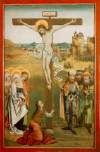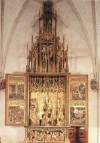 The high altar of St. Nicholas from Jánosrét (c. 1476) is characteristic of lively scenes, narration and dynamism accompanied by delicate Netherlandish-like landscape painting
.
The high altar of St. Nicholas from Jánosrét (c. 1476) is characteristic of lively scenes, narration and dynamism accompanied by delicate Netherlandish-like landscape painting
.

The altar from Krig, Szepesség, is a unique one of early date: it is, in fact, a housing which can be closed. The shape of the altar returns in a house altar in Szepesség (around 1360) which served as a reliquary: its owner said his prayers privately. This altarpiece - two wings of which are in the collection of the Hungarian National Gallery - carries on in function the tradition of the house altar of Queen Elizabeth.
The small house altar from Trencsén which is of about 100 years later follows the tradition of reliquary-altar, the Madonna-icon of Byzantine origin is accompanied by two female martyr saints, representing the delicate Czech style.
The fascinating figure of Mary of Németújvár is related to the soft style popular in Austria. The Calvary Altar by Tamás Kolozsvári (1427) in Garamszentbenedek has a particular significance in Hungarian works of international Gothic style.
At the same time when it was produced, Flemish realism found its followers in Central Europe. As the soft style was fairly popular, the change in style took place rather slowly. The first more realistic works of less delicate drapery are altar fragments. A type of altar became particularly popular in Szepesség but elsewhere, too, which involved a casket with two niches for two smaller statues, and wings which could be closed and were decorated by pictures. There were also triptychs at the time, some of which have survived.
Less delicate presentation on panels from Bát with events of life of St. Catherine on them refer to the 1430s. Changes in style are best expressed in the high altar of Mateóc.
The inclination to naturalism known from architecture can be traced in fine arts in the second half of 15th century, too. In large scale altarpieces of the period, painting and sculpture are merged, triptychs of high standard with architecture producing the illusion of space became more widespread. At the same time, a new expectation appeared: pictures were to follow realism rooted in painting of the Low Countries The master (GH master, 1471) of Trinity Altar in Mosóc obviously attempted to reach this goal. The Altar of Mary in Liptószentmária, the Altar of Passion in Medgyes and panels of the High Altar in Berethalom have much in common with Netherlandish painting.
From the 1470s onwards, the prevailing altar type was a casket with statues in it. The high altar in Kassa erected between 1474-77 in the Saint Elizabeth Church is contemporary with the Altar of Mary of Veit Stoss in Cracow. The great effect of the altar is reflected by its imitations (the high altar in St. Michael Church, Eperjes, and the altar of St. Elizabeth, Bártfa).
 The high altar of St. Nicholas from Jánosrét (c. 1476) is characteristic of lively scenes, narration and dynamism accompanied by delicate Netherlandish-like landscape painting
.
The high altar of St. Nicholas from Jánosrét (c. 1476) is characteristic of lively scenes, narration and dynamism accompanied by delicate Netherlandish-like landscape painting
.
The wish to visualise and narrate is best demonstrated by the Coffin of Christ from Garamszentbenedek. The tomb which is used during religious ceremonies at Easter is surrounded by figures of the apostles. A movable corpse of Christ was placed into it after it had been removed from the cross.
The new style appeared on altars of the provostal church in Szepeshely, Szepesség, and on the Vir Dolorum altar of St. Jacob Church, Lőcse (around 1476). The late Gothic style in painting very often appeared together with and substituted court art influenced by Italian quattrocento which was particularly popular with citizens. The late Gothic style reached its peak at the turn of the 15th century.
Netherlandish painting served as a style to be imitated until the turn of the 15th century when German masters of late Gothic became more dominant. Besides the graphic art of Dürer, Cranach, and Altdorfer, drawings of Italian masters like Pollaiuolo and Mantegna contributed to art with new ideas.
Master Pál of Lőcse was second to none in the Szepes region. It appears to be quite certain that he learnt his art in the workshop of Veit Stoss in Cracow, whose works he considered as his models. His most significant work is the high altar in the St. Jacob Church, Lőcse (1508-17) which is related to the Altar of Mary in Cracow in size, richness and dynamism of figures.
Due to his sons, the style of Veit Stoss came as far as Transylvania (the St. Michael altar in Segesvár, the altar in Berethalom finished in 1515 and the high altar in Szászsebes). In these works late Gothic dynamism is accompanied by wide forms of figures, and elements of late Gothic and Renaissance are present in the structure of ornaments.
 Pictures of the St. Barbara altar (1509) in Besztercebánya were produced by a significant painter following Dürer's cuts. As opposed to his statues slender and somewhat nervous, roundish figures of the high altar in the St. Catherine Church indicate that, besides Stoss' style, Hungarian altar sculpture was probably influenced by Southern German artists, too.
Pictures of the St. Barbara altar (1509) in Besztercebánya were produced by a significant painter following Dürer's cuts. As opposed to his statues slender and somewhat nervous, roundish figures of the high altar in the St. Catherine Church indicate that, besides Stoss' style, Hungarian altar sculpture was probably influenced by Southern German artists, too.
Altars in mining towns developed to a delicately floating ornamentation and an excellent style of emotional landscape painting of the Danube school (altars in Zólyomszászfalu).
The style of the Danube school gained a special flavour in Transylvania (Passion scenes from the year 1514, the altar of Csikmenaság from the year 1543) and is associated with Renaissance ornamentation.
The most original artist of late Gothic style is Master MS, an artist who worked in Selmecbánya in 1508 and who represented the peak of Hungarian art in the Middle Ages.
The collection of the Hungarian National Gallery presents an overview of the winged altarpieces in Hungary from the 14th-16th century.